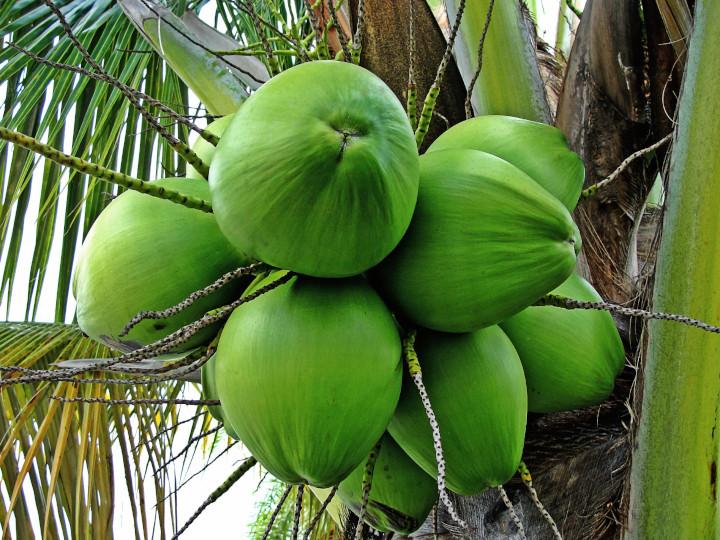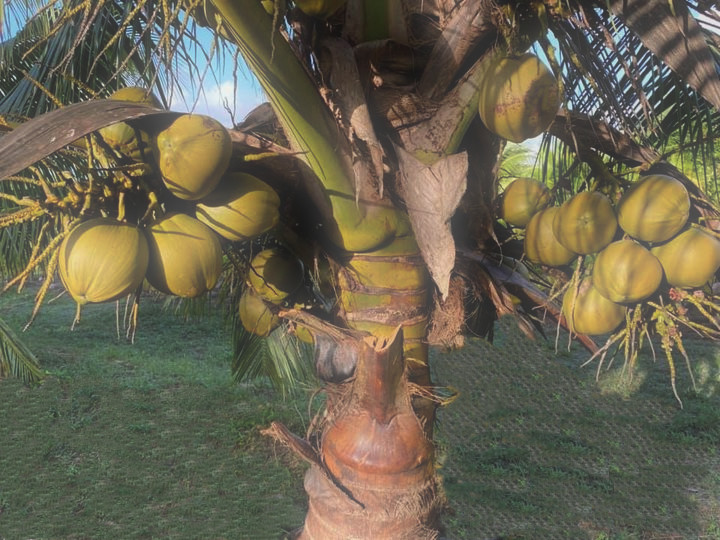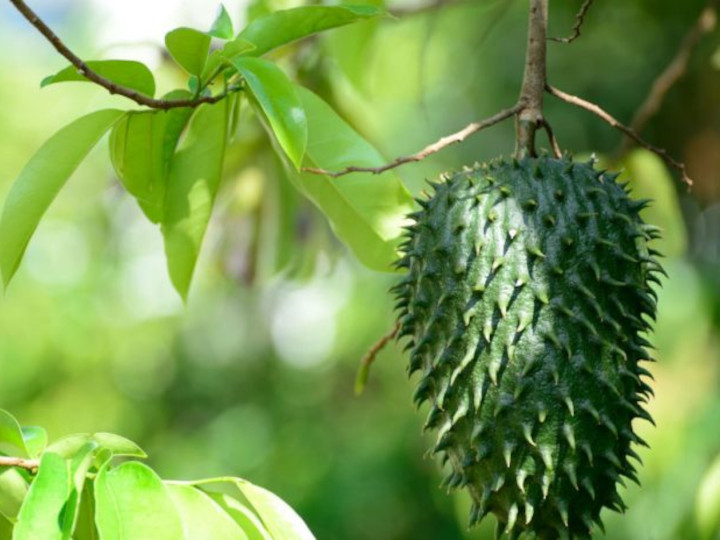
The Brazil Green Dwarf
The Brazil Green Dwarf (BGD) is a legendary coconut variety renowned for its delectable qualities. Its young nuts, known for their sweetness and deliciousness, are commonly sold for refreshing drinks on the famous tropical beaches of the Americas. Tracing the historical origins of Green Dwarf varieties worldwide has proven to be a challenging endeavor.
The fruits of this variety are characterized by their oblong shape and vibrant green hue. Their average weight typically falls within the range of 556 grams to 800 grams. Inside the fruit, the nuts are nearly spherical, with an average weight ranging from 353 grams to 556 grams, and they contain an average of about 400 cc of water.
Remarkably, the younger the fruit, the higher its water content, making it a valuable source of essential nutrients. It delivers a rich blend of sugar, dietary fiber, antioxidants, proteins, as well as a medley of vital vitamins and minerals. In recent times, it has garnered recognition as a sought-after sports beverage, offering an invigorating combination of energy, hydration, and endurance. Notably, coconut water plays a vital role in rectifying electrolyte imbalances, whether induced by digestive ailments like diarrhea, the aftermath of strenuous exercise, or the aftermath of vomiting.
In critical situations, such as medical emergencies, coconut water takes center stage for its unique ability to seamlessly integrate with blood, a property that opens the door to life-saving infusions. Beyond its rehydration capabilities, it exhibits a broad spectrum of health-enhancing qualities, encompassing antiseptic, antibacterial, anti-fungal, and anti-viral properties. Additionally, it serves as a reliable remedy for fluid loss stemming from conditions like influenza, typhoid, and malaria, and it boasts the remarkable ability to facilitate the dissolution of kidney stones. The Brazil Green Dwarf, with its multifaceted attributes, emerges as a remarkable natural elixir celebrated for its versatility and contributions to health and well-being.

Chactemal Hybrid Coconut
The Chactemal Hybrid Coconut, a distinctive Mexican hybrid variety, is the remarkable outcome of a crossbreeding between the Malayo Dwarf Yellow coconuts (MEA) and the Criollo Alto Michoacán (CAMICH) coconuts. It boasts a unique set of characteristics and versatile uses that make it highly valued in the agricultural landscape.
One of its standout features is its remarkable tolerance, with an impressive 85% resistance to Lethal Yellowing, a common coconut palm disease. This resilience sets it apart as a preferred choice for cultivation. Furthermore, the Chactemal Hybrid Coconut exhibits a precocious nature, delivering a copra yield of 2.8 to 4.0 tons per hectare under rainfed and irrigated conditions, respectively. This prolific yield makes it an economically attractive option for coconut growers.
The Chactemal Hybrid Coconut is characterized by its vigorous and robust growth, yielding an abundance of medium-sized bronze-green coconuts. These coconuts have an average weight ranging from 650 grams to 1,090 grams. Within these fruits, the nuts are nearly spherical and have an average weight ranging from 353 grams to 556 grams, containing approximately 750 cc of water on average.
The white meat or flesh of the coconut is consumed fresh. When it is in a dried form, it is referred to as copra. It is rich in vitamins, particularly vitamin A and the B group (with a special emphasis on B5), as well as essential minerals such as phosphorus, iron, magnesium, zinc, and potassium. Additionally, it is high in fat and carbohydrates, making it a widely used ingredient, whether fresh or dried, in thousands of culinary dishes. Desserts and confectionery particularly benefit from the coconut’s sweet taste, and it serves as an essential component in many curries and savory dishes around the world. Finally, copra cake or copra meal is produced as livestock feed.

Fresh Soursop
Soursop, scientifically known as Annona muricata, is a tropical species with fruits that boast a plethora of health benefits. It finds extensive use in the preparation of juices, smoothies, and desserts. Its unique chemical composition makes it particularly effective in addressing immune system issues and maintaining healthy bone and dental structures.
This prickly, green-skinned, oval-shaped tropical fruit typically measures between 10-30 cm in length and 7-15 cm in width, with an average weight of around 4 kg. The inner pulp is soft, generally white, and characterized by its meaty and juicy texture. Soursop’s flavor is a delightful blend of sweetness and sourness, accompanied by an aroma reminiscent of pineapple. Within the fruit, numerous black seeds can be found.
Soursop offers a multitude of benefits. It contains compounds that help maintain the body’s overall well-being, fortifying the immune system and providing protection against viral and infectious diseases. Much of this benefit is attributed to its considerable vitamin C content, with approximately 20 mg per 100 g of edible portion. Furthermore, this vitamin makes soursop a potent antioxidant.
The antioxidants found in soursop, along with other components, support the elimination of toxins and waste materials, safeguarding the liver and gallbladder. The fruit’s high calcium content, at 14 mg, contributes to the maintenance of healthy bones and dental structures. It’s not just about calcium; the presence of phosphorus also plays a significant role in preserving bone tissue. Finally, it’s worth noting that soursop is an excellent natural energizer, thanks to its content of B vitamins. These vitamins are essential for maintaining the proper function of nerves and provide an added boost to overall vitality.

